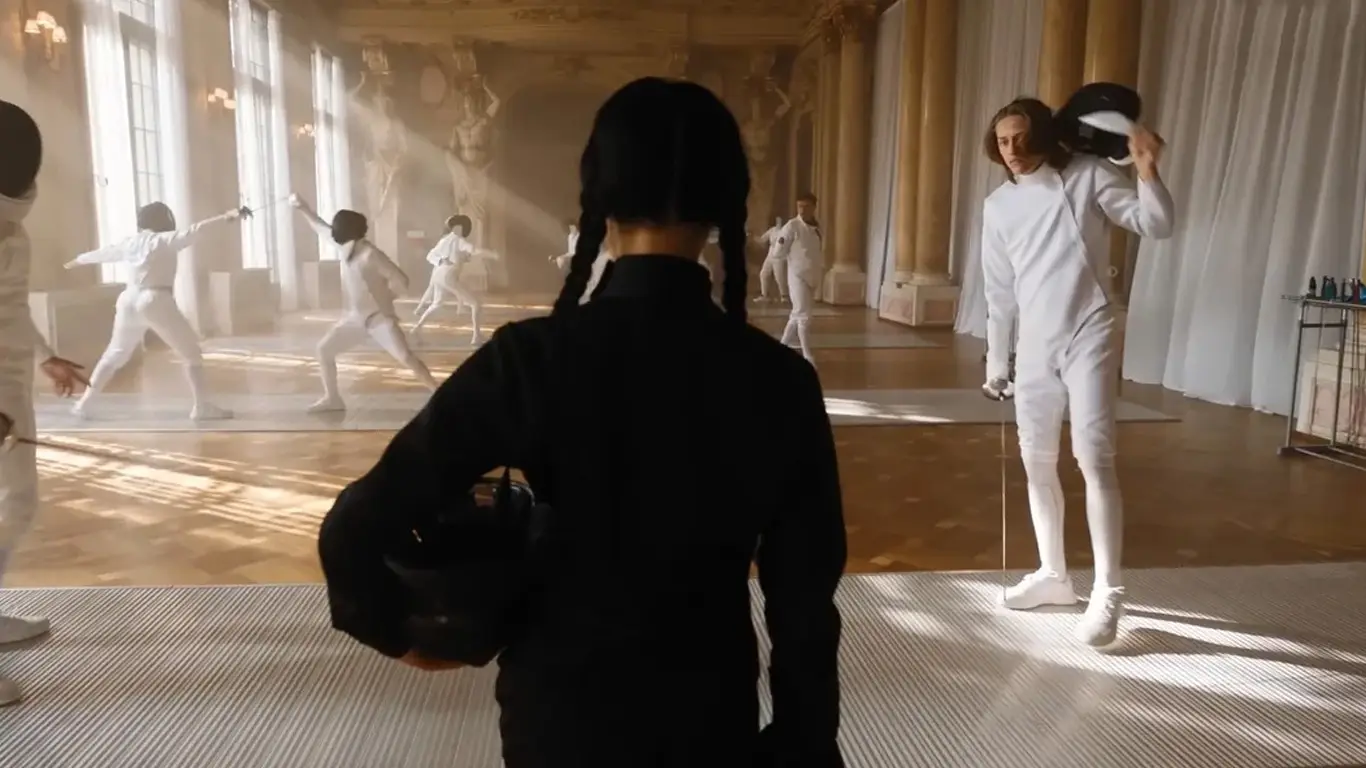Once seen as an elite, almost hidden sport, fencing is now carving its way into pop culture like never before. From the iconic lightsaber duels of Star Wars to the elegant swordplay in series like Wednesday or The Witcher, fencing-inspired combat has taken center stage in film, TV, and even video games. But what’s behind this surge in visibility? Why are blades suddenly cooler than ever? And how is this cultural shift influencing real-life fencers—and the fashion they wear?
The Rise of Fencing in Pop Culture – From Star Wars to Netflix
Star Wars – The Lightsaber as the Ultimate Symbol
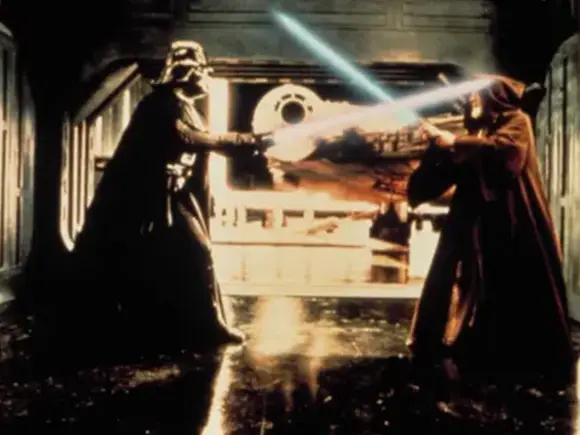
The duels between Jedi and Sith are choreographed with real fencing principles. The lightsaber has become the most iconic fictional weapon, blending elegance and power, and introducing generations to the rhythm of swordplay.
When it comes to pop culture and fencing, nothing has done more to elevate the mystique of the blade than Star Wars. Since 1977, the lightsaber has become not just a fictional weapon, but a cultural icon—instantly recognizable, deeply symbolic, and endlessly referenced.
But here’s what many don’t realize: lightsaber combat was heavily inspired by real fencing techniques. The original trilogy choreographers, including Bob Anderson (an Olympic fencer and fencing master), brought classical fencing principles into the duels. Parries, lunges, binds, and footwork in many of the early Jedi and Sith battles were derived from épée and sabre disciplines, giving the fights an elegant, stylized realism. Later films expanded the combat into more acrobatic territory, but the fencing DNA remained—emphasizing focus, form, and precision.
The lightsaber also carries deeper meanings that parallel the sport of fencing:
-
Discipline over chaos
-
Control over brute strength
-
Mastery through repetition
Jedi are trained like elite athletes—mentally and physically. Their weapon, like a fencing blade, is an extension of their will. For generations of fans, this turned the sword into something aspirational—not just a tool of violence, but of personal growth and identity.
For young fencers today, the lightsaber is often their first introduction to fencing’s aesthetic. It’s cool. It’s cinematic. It’s sharp.
And it begs the question:
What if fencing gear—and streetwear—could capture that same feeling?
That’s exactly what FNCNG aims to do.
The Witcher – Swordplay Meets Fantasy
Geralt’s fighting style blends real techniques with fantasy flair. He embodies the lone warrior ethos—a rule-bender with an inner code—similar to many fencing archetypes.
In recent years, The Witcher franchise—first as a cult-favorite video game, then as a hit Netflix series—has redefined the way fantasy portrays swordsmanship. At its core stands Geralt of Rivia, a lone warrior with unmatched combat skills, whose fighting style fuses brutal efficiency with striking elegance. And while the setting is fantastical, the swordplay is grounded in real-life fencing and historical martial arts techniques.
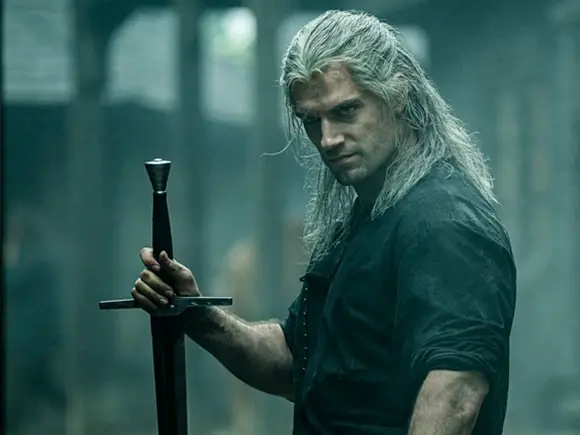
Geralt’s movements—precise footwork, strategic parries, and swift ripostes—mirror those of a sabreur or a longsword duelist. His fighting isn’t about flashy acrobatics or overwhelming strength, but about reading his opponent, exploiting timing, and maintaining perfect control—exactly the kind of mindset that resonates with real-world fencers.
What makes The Witcher especially powerful as a fencing touchpoint in pop culture is its tone: raw, anti-heroic, and independent. Geralt isn’t part of an elite fencing academy—he’s a mutant outcast who made his skill his identity. That speaks volumes to younger audiences, who increasingly seek authenticity over tradition.
The show’s popularity and the character’s cult following have made swordsmanship “cool” again, not as an aristocratic sport, but as a gritty, individualistic art form. This aligns perfectly with FNCNG’s vision: bringing fencing out of the hall and into the streets, where personality, edge, and subculture meet.
Wednesday – Fencing on the Gen Z Radar
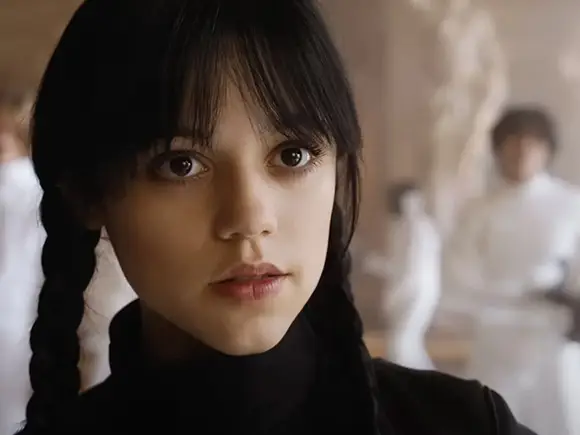
In the hit Netflix series, Wednesday’s fencing match isn’t just a stylish scene—it’s a character-defining moment that helped introduce fencing to a new, younger audience in a cool, mysterious context.
When Wednesday premiered on Netflix, it wasn’t just the dark humor and gothic vibes that captured audiences—it was also the unexpected inclusion of fencing as a key part of the show’s aesthetic and narrative. In one of the early episodes, Wednesday Addams engages in a dramatic fencing duel at Nevermore Academy, instantly making the sport mysterious, stylish, and relevant to a whole new generation.
What made this moment pop was how effortlessly fencing was woven into the show’s identity. Dressed in all-black uniforms, with intense glares and classical posture, the duel wasn’t just a scene—it was a statement. Fencing became part of Wednesday’s personality: disciplined, sharp, introverted but fierce. And Gen Z noticed. The clip went viral, cosplay followed, and Google searches for “fencing sport” and “Wednesday fencing scene” spiked.
This matters—because for many young viewers, this was their first real exposure to fencing. Not through the lens of Olympic competition, but as a visual, emotional, and cultural expression. Suddenly, fencing wasn’t just something done in private clubs—it was something that could feel alternative, underground, even cool.
For FNCNG, this shift is huge. It confirms what we believe: that fencing belongs not just in tournaments, but in identity, in fashion, and in culture.
Lord of the Rings / The Hobbit – The Noble Weapon
The elegant swordplay of elves and noble warriors elevated fencing to a symbol of grace, honor, and heroism, embedding it in fantasy lore.
In The Lord of the Rings and The Hobbit trilogies, swords are more than weapons—they are symbols of lineage, destiny, and inner strength. Whether it’s Aragorn’s reforged Andúril, Frodo’s Sting, or the elvish blades wielded with fluid elegance, Tolkien’s world presents swordsmanship as an art tied to honor, heritage, and purpose.
The choreography of the fights—especially among the elves—leans heavily on fencing-like precision and grace.
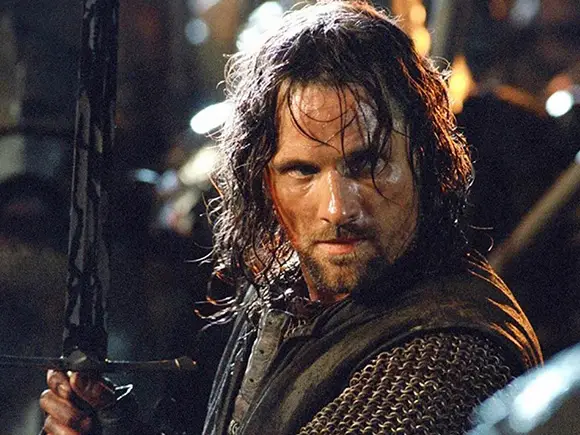
Legolas, for example, moves with almost balletic rhythm, evoking a style that feels both natural and trained. While these fantasy duels may not follow Olympic rules, they carry the spirit of fencing: strategic timing, respect for the opponent, and a deep understanding of one’s weapon.
More than that, the blade itself becomes a character. It has a name. A story. It’s passed down or reforged to signify transformation. And this resonates deeply with fencers, for whom the sword is also more than steel—it’s a reflection of identity and personal evolution.
Pop culture moments like these reinforce fencing’s timeless mystique. They remind us that to carry a blade is not just to fight—but to represent values like courage, discipline, and legacy.
Video Games – Precision as Power
Games like For Honor, Ghost of Tsushima, and Assassin’s Creed feature dueling mechanics that echo fencing’s emphasis on timing, reflex, and strategy—bringing the essence of fencing into interactive culture.
Modern video games have done more than just entertain—they’ve become immersive platforms where the essence of fencing thrives in new, unexpected forms. Titles like Ghost of Tsushima, For Honor, Sekiro: Shadows Die Twice, or even Assassin’s Creed rely on swordplay systems built around timing, reading your opponent, precision strikes, and clean defensive play—core principles shared with real-life fencing.
In games like For Honor, combat isn’t just button mashing—it’s a tense mental duel, with parries, feints, and counters that mirror the real-world psychological game of épée or sabre. Ghost of Tsushima takes it even further, turning sword fighting into a cinematic dance of flow and focus, often resembling a kendo or fencing bout.
Why does this matter? Because gaming is Gen Z’s pop culture capital. And in this world, the sword is no longer historical—it’s interactive, personal, and deeply satisfying. Gamers are learning, even subconsciously, that victory comes from control, not chaos. From accuracy, not aggression.
And that’s fencing at its core.
As more young people engage with swordplay through gaming, the line between sport and culture fades. Suddenly, wearing a fencing-inspired hoodie isn’t niche—it’s a nod to a skillset they value, admire, and practice digitally.
Real-Life Blade Legends – Fencing’s Modern Heroes
While Hollywood brings us choreographed sword fights, the real fencing world has its own icons—athletes who’ve turned precision and passion into legend. Names like Aron Szilágyi, the three-time Olympic champion in men’s sabre, or Inna Deriglazova, the dominant force in women’s foil, have redefined excellence in the sport. There’s also Sandro Bazadze, whose explosive style makes him a fan favorite, and Korea’s Sanguk Oh, the Olympic gold medalist with unmatched speed and power. These athletes don’t just win—they inspire a new generation, proving that fencing is far more than a niche sport. They are the real heroes behind the blades, and they’re reshaping how the world sees fencing.

Where Fencing Meets Pop Culture: The Identity Behind FNCNG
FNCNG is more than a sportswear brand—it’s a cultural bridge between the disciplined world of fencing and the expressive energy of modern pop culture. Drawing inspiration from iconic sword-bearing figures like Jedi knights, Geralt of Rivia, and fantasy legends, FNCNG reimagines fencing not just as a sport, but as a wearable identity. The brand taps into the visual and emotional power of pop culture’s most memorable blades, blending their spirit into street-ready, limited-edition designs. In doing so, FNCNG makes fencing visible beyond the piste—turning precision, control, and character into fashion that speaks to a new generation. For those who grew up watching duels on screens and now train with real steel, FNCNG is the gear that connects their passion to their presence.

